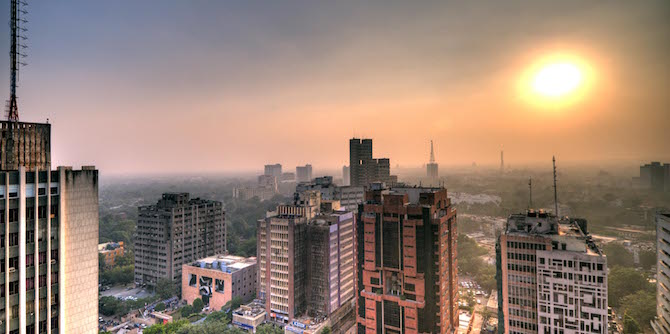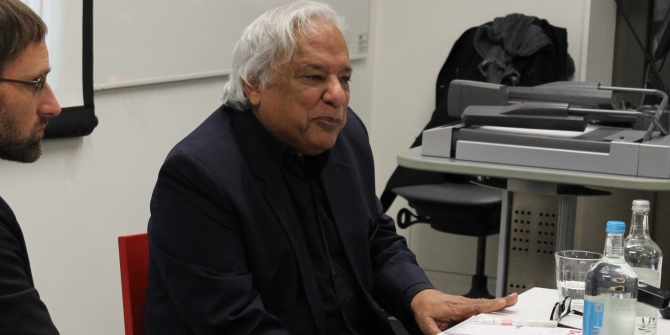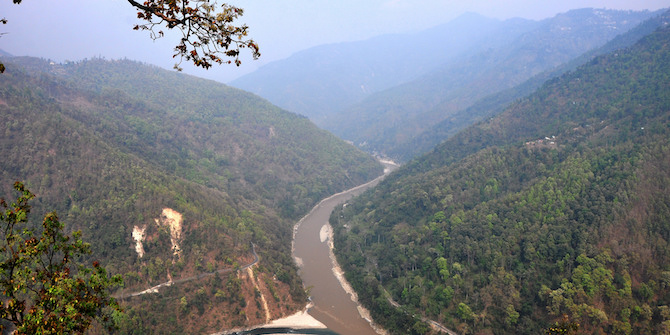 Drought in Pakistan’s Thar Desert is a commonplace occurrence, resulting in high casualties and long term health problems for communities. Marielle Velander explores the strengths and weaknesses of a major initiative to address the water shortages, which also sheds light on the interrelationship between water and energy concerns in the area.
Drought in Pakistan’s Thar Desert is a commonplace occurrence, resulting in high casualties and long term health problems for communities. Marielle Velander explores the strengths and weaknesses of a major initiative to address the water shortages, which also sheds light on the interrelationship between water and energy concerns in the area.
Water scarcity is not just a headline, but also a frighteningly deadly reality in Tharparkar, one of Pakistan’s poorest districts, with the lowest Human Development Index in the country. Located in the south-eastern corner of Sindh bordering India’s famous Rann of Kutch salt marsh, Tharparkar’s 914,000 inhabitants have experienced severe drought 11 of the past 30 years. The most recent drought crisis occurred in 2014, and resulted in hundreds of casualties, many of them children suffering from health conditions of malnutrition and diarrhoea. The 2014 drought had a lot of media coverage, contrasting starkly with the arguably slow governmental response. This ignited a debate on whether the cause for the large amount of casualties, in a community that had lived in these harsh conditions for centuries, found its root in administrative negligence, the conditions of local facilities, or was simply an annual occurrence sensationalised by the media to attract more funds into the coffers of development organisations.
Fast forward to 7 January 2015, when former Pakistani President Asif Ali Zardari inaugurated Asia’s largest reverse osmosis (RO) filter plant in Mithi, the administrative capital of Tharparkar. The Solar Hybrid Reverse Osmosis Water Desalination Complex in Mithi has the capacity to provide 2 million gallons (8 million liters) of drinking water per day in Mithi through distribution lines to each and every house in Mithi City, Islamkot City and Nagarparkar city, covering more than 300,000 people. The local government has invested a whopping 5.4 billion Pakistani rupees to install 750 of these RO plants, with the one in Mithi being the largest. They have been spread across the parched Tharparkar landscape between January and June 2015, and have been heralded by the local government, water charities, and media sources as a significant step towards solving the water crisis that caused the many deaths last year.
This project, however, does not only touch on water issues, but also intersects with energy concerns in this under-electrified region. First of all, the plants are administered by the Sindh Coal Authority rather than an authority principally occupied with water. Furthermore, the RO plants are partially solar-powered, drawing on a renewable resource that has gained currency as the new promising humanitarian good in the arid parts of South Asia. Anthropologists such as Jamie Cross have begun to look at the social relationships underlying (and often preventing) the successful adoption of solar-powered goods in India, yet alternative energy sources are sorely needed in an area where power outages are frequent.
Global trends surrounding corporate social responsibility and business ethics are also gaining traction in this area of Pakistan. Pak Oasis Industries, a leading provider of water treatment facilities in Pakistan, includes this among its list of water purification plants that fit under its CSR scheme providing clean drinking water to the most impoverished communities in Pakistan free of cost. Finally, the project is specifically targeted to make life easier for the local women, who often have to walk 2 km to fetch water. Ethnographic work by Lyla Mehta in bordering Kutch highlighted how women are the segment of the population suffering the most from water scarcity. However, Mehta, and other social scientists such as James Ferguson and James Scott conducting fieldwork amidst development projects, suggest that these large schemes to pull thousands out of poverty simultaneously should be avoided, as their large-scale political flourishes don’t remain sensitive to the highly complex social lives and micro-politics of the places like Tharparkar that are sought to be developed. Is installing a water purification plant enough to instigate the progressive change expected from this project?
As with most development initiatives, the Tharparkar project has its critics. On a practical level, the water plant in Mithi has already been reported of supplying brackish water. Some experts of the region have suggested that water canals installed with a natural indigenously made filter – rather than expensive equipment from Europe and North America that locals are not familiar with maintaining – would have been more efficient and inexpensive. Local NGOs, such as Thardeep Rural Development Programme and Association for Water Applied Education and Renewable Energy (AWARE) have been trying to implement these locally sourced, grassroots approaches for years on limited funds. Contradicting these criticisms, a report released by Senior Civil Judge Mian Fayyaz Rabbani in March 2015 reported that the plants were working effectively, as long as some additional provisions were made.
Both solar-powered RO plants and government-funded water canals have been tried across the border in India, with varied degrees of success, from the solar-powered RO plant supplied in Kotri by celebrated NGO the Barefoot College to the wasted government investment into the Indira Gandhi Canal in Rajasthan. The interrelationship between water and energy concerns and solutions in this case also recalls another popular development technology of India and Pakistan—dams, 150 of them in the pipeline in India even after extensive activism and scholarship highlighting their unsustainable and underperforming outcomes. Dams were once hailed as “temples of modernity” in the region. Will these RO plants be the next great government-funded models of modernity for India and Pakistan?
Tharparkar is an enigmatic case for its contrasting image in the media. On the one hand, it gives rise to a wave of articles on crisis, disease, and despair, and on the other hand it is a surprising utopia of religious pluralism. Mithi is one of the few towns in Pakistan with a Hindu majority, and in March a young journalism student travelled there to report on the rare yet beautiful respect the Hindu and Muslim communities appear to have for one another. These actions include Hindus fasting alongside the Muslims during the month of Ramadan, and Muslims participating in Holi together with the Muslims of the town. Bells calling Hindu prayer times are not rung while Muslims pray, and the Muslim call for prayer is not played on loudspeaker when Hindus pray. This reported religious syncretism near the India-Pakistan border makes this place even more compelling, symbolic of a complex and contested history in which resource scarcity converges with a richly multicultural society.
This summer, the region has been hit with the worst heat wave in 150 years. Once again, many deaths were reported in the district, along with power outages and water shortages. Reports and articles from all directions are only predicting these conditions to get worse. As Pakistan scrambles for the right solutions to these natural resource issues, which will only exacerbate the extremism being tackled with such force by the country’s many brave moderates, what is the right path forward? This ongoing debate in this remote corner of Pakistan has profound implications for our conceptions of vulnerability and resilience. Defining and understanding these terms are essential to designing sustainable and feasible models for adaptation to that all-important issue of our time, climate change. Questions around addressing water scarcity are more important than ever as the UN meets in September to discuss whether providing clean drinking water should be the sixth Sustainable Development Goal, and for UNFCCC discussions in Paris in December to combat climate change and improve the distribution and management of our natural resources.
Note: This article gives the views of the author, and not the position of the South Asia @ LSE blog, nor of the London School of Economics. Please read our comments policy before posting.
About the Author
 Marielle Velander is an LSE Masters candidate in Anthropology and Development with a specific interest in water issues in South Asia. Before starting at LSE she spent the summer in Lucknow studying Urdu intensively as a recipient of the U.S. State Department Critical Language Scholarship. She tweets @mariellewel.
Marielle Velander is an LSE Masters candidate in Anthropology and Development with a specific interest in water issues in South Asia. Before starting at LSE she spent the summer in Lucknow studying Urdu intensively as a recipient of the U.S. State Department Critical Language Scholarship. She tweets @mariellewel.
Marielle is a regular contributor to South Asia @ LSE. You can view her previous posts here.







